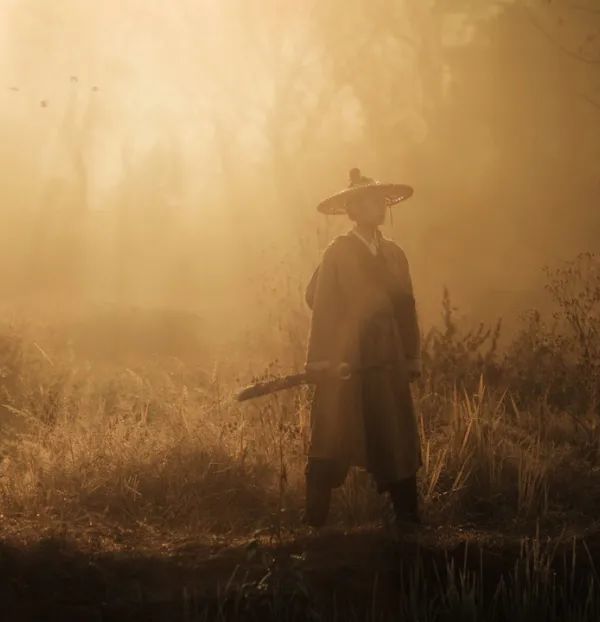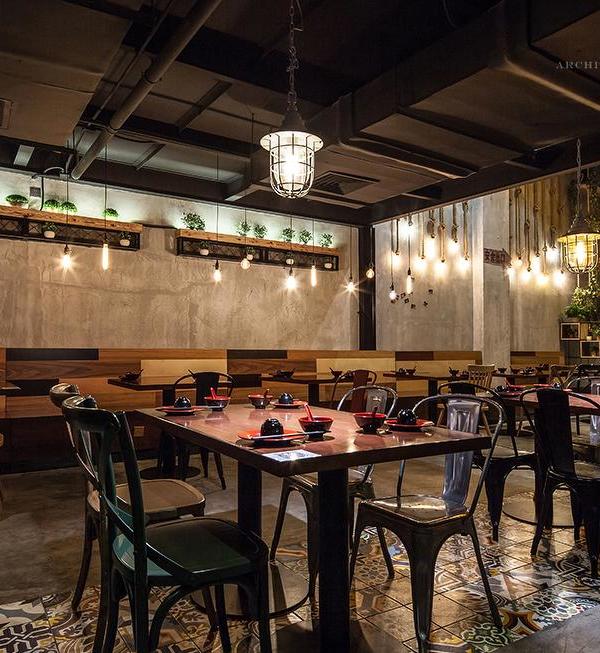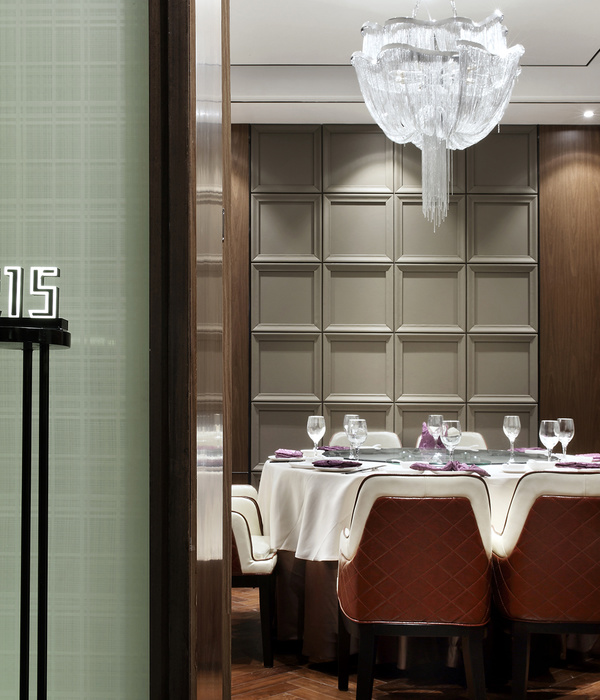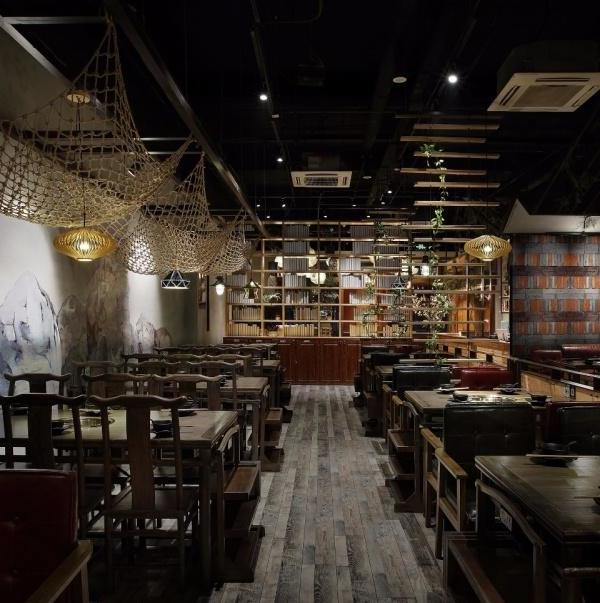今年秋天于荷兰海牙开幕的Foodhallen美食广场在众多老顾客中掀起了一阵热潮。这是继阿姆斯特丹和鹿特丹门店之后,又一间经过精心打磨的美食广场。新的广场位于布满高档店铺、建筑风格迥异的HaagscheBluf商场内。Modijefsky工作室将整个餐厅内部打造得充满活力,使顾客能够尽享当地风土人情。
Fans of the carefully curated Foodhallen venues will be no doubt excited about the latest location opening its doors this autumn in Den Haag. After two intensely popular food courts in Amsterdam and Rotterdam, the most recent venue is located within HaagscheBluf – a hidden away area of luxury shops and contrasting architectural styles. With an interior designed by Studio Modijefsky, the brand-new hall is a vibrant space to enjoy local people and flavours.
▼北视图,North view ©Maarten Willemstei
新的美食广场环绕着HaagscheBluf的内部庭院,横跨三个相邻建筑,连接多层空间和不规则的网格结构。设计简化了原本由柱子、门梁和楼梯组成的混乱“森林”,将低矮黑暗的室内变成了一个具有传统欧式露天广场风格的公共空间。Modijefsky选择了地标、夺目的路面、喷泉、楼梯、商铺、游乐场和雕像这七个可以在经典城市广场中找到的独特元素,并用它们来代表不同的现代建筑结构,从而形成一种新的、能将空间联系起来的设计语言。
▼广场入口区域,entrance area ©Maarten Willemstei
▼从角落看向中央酒吧,look at the central bar from the corner ©Maarten Willemstei
Wrapped around an internal courtyard of the HaagscheBluf, the food court spreads across three adjoining buildings, connecting multiple floor levels and irregular structural grids. The new design simplifies the original chaotic ‘forest’ formed of existing columns, beams and staircases, turning the dark and low interior into an open public space heavily inspired by the tradition of the greatest European piazzas. For the basis of the concept Studio Modijefsky chose seven unique elements which can be found in all the typical urban squares: landmarks, striking paving, fountains, stairs, merchant stalls, playgrounds and statues. Each of those objects has been translated into a contemporary architectural component, forming a new design language which links together the spaces forming the venue.
▼改造后的空间颜色更为鲜艳也更具活力,the color of the transformed space is brighter and more vibrant ©Maarten Willemstei
▼酒吧采用了青铜、红色大理石和陶土瓷砖材料,the bar is made of bronze, red marble and ceramic tiles ©Maarten Willemstei
空间中最为突出、最具城市景观性质的部分是位于中心的复合酒吧,由朝向入口的主酒吧和位于另一侧的私密鸡尾酒吧构成。两个体量都采用了青铜、红色大理石和陶土瓷砖材料,与酒吧的基座和地板无缝结合。不同尺寸和颜色的瓷砖参照城市广场中所使用的铺砌图案,与水泥浇筑的地面一起,用以区分或连接不同的空间。顺势而建的大型平铺长凳就像为顾客定制的固定座椅。
▼不同尺寸和颜色的瓷砖将空间划分成多个区域,tiles of different sizes and colors divide the space into areas ©Maarten Willemstei
▼从下沉空间向中央区域看去,view from the sunken space to the central area ©Maarten Willemstei
▼每个商铺都拥有自己独特的风格,each store has its own unique style ©Maarten Willemstei
The most prominent, iconic part of the urban landscape – the landmark – is represented by a centrally positioned bar, divided into two parts. The large main bar faces the entrances, while the opposite side forms a more intimate cocktail bar. Both volumes are finished with bronze, red marble and terracotta tiles, seamlessly merging with the floor and plinths of columns. The tiles come in various sizes and colours, mixed with poured flooring, referencing paving patterns used in urban squares, differentiating or connecting different levels in space. Various floor heights have been used to their advantage, with large tiled benches raising from the ground, forming custom fixed seating arrangements.
▼顺势而建的大型平铺长凳就像为顾客定制的固定座椅,large tiled benches raising from the ground, forming custom fixed seating arrangements ©Maarten Willemstei
▼用餐区域细部,details of the dining area ©Maarten Willemstei
▼每个区域的色彩、图案与材质都搭配得当,the color of each area, design and material are tie-in proper ©Maarten Willemstei
改造后的大型楼梯成为了可供顾客聚会的全新结构元素。之前的实用型楼梯被一个大型定制结构所取代,成为一个可作为临时座位区的完美据点。它由覆盖了水磨石和马赛克瓷砖的木材制成,亮眼得让人不管身处何处都难以忽视。广场中的每个角落都经过精心设计,是大型团体和私人聚会的绝佳场所。即便是整个室内最小的房间也被改造成了一个半管型的滑板游乐场兼舞池。
▼大型定制楼梯结构,large custom stair structure ©Maarten Willemstei
Another structural element reinvented as a social place for people to gather on is a large staircase. Previous strictly practical stairs were replaced by a large bespoke structure – a perfect meeting point which can be used as makeshift seats and tables. Made of wood with terrazzo and mosaic tiles and visible from various points within the venue, it also invites people to explore the upstairs bar. Throughout the space each corner has been thoughtfully considered and turned into the best possible party spot, offering endless opportunities for both large groups and more private gatherings. Even the smallest room of the whole interior has been turned into a playground mimicking skateboarding half-pipe – a space which can double as a dance floor.
▼楼梯细部,details of the staircase ©Maarten Willemstei
作为历史象征的雕像元素在广场中由结构柱来代表,它们的形状和饰面取决于它们所在的位置。环绕在酒吧周围,装有青铜饰面材料的柱子最具雕塑感。被深蓝色瓷砖覆盖的支撑墙与整体空间的轻量元素、植物和氧化铜材料相结合,为室内增添了色彩,也是喷泉的抽象表现。广场上的一排排柱子均覆盖着取自地中海广场的传统黄铜材料。
▼装有青铜饰面材料的柱子最具雕塑感,columns with bronze finishes are the most sculptural ©Maarten Willemstei
Statues, as symbols of the historical past, are represented by structural columns. Their shapes and finishes differ depending on their position within the space. Columns surrounding the bar are the most sculptural, finished with bronze facing material. Chosen supporting walls clad in dark blue tiles, combined with integrated light elements, plants and oxidised copper are an abstract representation of fountains, bringing colour into the interior. Remaining columns are clad in brass, yet another material taken from the tradition of the Mediterranean piazzas.
▼被深蓝色瓷砖覆盖的支撑墙与整体空间的轻量元素、植物和氧化铜材料相结合,为室内增添了色彩,chosen supporting walls clad in dark blue tiles, combined with integrated light elements, plants and oxidised copper bringing colour into the interior ©Maarten Willemstei
室内的最后一个象征性元素为商铺,由位于建筑底层的小吃摊来体现。12个摊位分布在开放广场的外沿,有三种可供商贩自由选择的空间尺寸和图形标识。摊位的设计既要体现品牌的创造力,也要保证空间的整洁有序。整个内部空间在充当海牙街头美食的白色背景布的同时,还需保留Foodhallen美食广场的独特标志。
The final symbolic element of the interior: the food stalls, representing traditional merchant’s stalls, are located on the ground floor of the building. Placed on the outskirts of the open space, 12 stalls come in three different sizes and unique graphic identities, chosen by the vendors themselves. This posed a significant challenge of creating clear design guidelines for the stalls’ owners – rules which would not restrain the creativity of each brand, but at the same time result in a wholesome interior in its own right. The overall space must be a blank canvas for The Hague’s street food scene, while remaining a signature Foodhallen venue full of unique character.
▼顺势而建的临时座位区域,a temporary seating area ©Maarten Willemstei
▼区域细部,details ©Maarten Willemstei
▼柔软的木质家具和绿色植物缓解了硬质材料和线条带来的僵硬感,soft wood furniture and greenery ease the stiffness of hard materials and lines ©Maarten Willemstei
与繁华的底层相比,Foodhallen的上层更加明亮、更有条理感。这里的地标性建筑是一间由石灰石、绿松石、氧化铜和浅色水磨石台面制成的酒吧。强烈的垂直线条使空间在视觉上更显高挑,镜子和光线的结合模拟了水从后面流下来的情景。二楼拥有几何木质地板,且再一次采用了定制座位的元素。现有的如墙墩等结构元素,通过成为由不同的灯、面板和饰面组成的抽象墙的一部分,来得以强调和突出。
▼更加明亮、更有条理感的二层空间,brighter, more organized second floor space ©Maarten Willemstei
▼由石灰石、绿松石、氧化铜和浅色水磨石台面制成的酒吧,a bar made of limestone, turquoise, copper oxide and light-colored terrazzo countertops ©Maarten Willemstei
In comparison with the bustling ground floor, the upper level of Foodhallen has a slightly brighter and more organised feel. Here the landmark is a bold fountain bar made of travertine stone, turquoise oxidised copper and light-coloured terrazzo top. Strong vertical lines make the space optically taller, while the combination of mirrors and light imitates water running down the back bar. The floor of the upstairs space is made of wooden planks forming a geometrical pattern, once again merging into elevated custom seating elements. Existing structural elements such as wall piers are highlighted and celebrated by becoming a part of an abstract wall composition made of diverse lights, panels and finishes.
▼酒吧细部,details of the bar ©Maarten Willemstei
散布在酒吧上方的醒目的黄铜吊灯,以及布置在横梁下清晰的LED灯等一系列现代元素为室内增添了动感。它们鲜明的节奏被用来强调酒吧中心位置的一层方形结构梁打断。柔软的木质家具和绿色植物缓解了硬质材料和线条带来的僵硬感。
Contemporary features such as striking brass chandelier spreading above the bar and clear lines of the LED lights placed on the undersides of the beams add a dynamic graphic layer to the interior. Their stark rhythm, interrupted by a square layer of structural beams, emphasizes central position of the bar within the space. Hard materials and lines are alleviated by a warmer layer of loose wooden furniture and green plants.
▼几何木质地板与定制座位,geometric wood flooring with custom seating ©Maarten Willemstei
通过使用图形线条、清晰的材料组合和概念符号,Modijefsky工作室创造了一个完美的现代室内广场。各式各样吸引人的、充满奇趣的城市景观适用于任何场景。虽然Foodhallen是一家以美食而闻名的公司,但它充满活力、精致有趣的室内设计也同样让人流连忘返。
By using graphic lines, clear material palette and conceptual symbols, Studio Modijefsky has created the perfect modern indoor piazza. A versatile and inviting urban landscape filled with quirky features, perfect for any occasion. While Foodhallen concept prides itself on celebrating cuisines and flavours, it’s the new vibrant, intricate interior which will keep you returning.
▼其他细部,other details ©Maarten Willemstei
▼一层平面,the first floor plan ©Studio Modijefsky
▼二层平面,the second floor plan ©Studio Modijefsky
Location: The Hague, The Netherlands Program: food court, bar & event space Status: realised October 2019 Size: 1256 sq.m. ground floor: 825 sq.m. first floor: 288 sq.m. terrace: 143 sq.m. Client: Foodhallen Design: Studio Modijefsky; Esther Stam, Natalia Nikolopoulou, Zahra Rajaei, Nancy Katri, Christel Willers, MaiteMargalho Photography: Maarten Willemstei
{{item.text_origin}}












